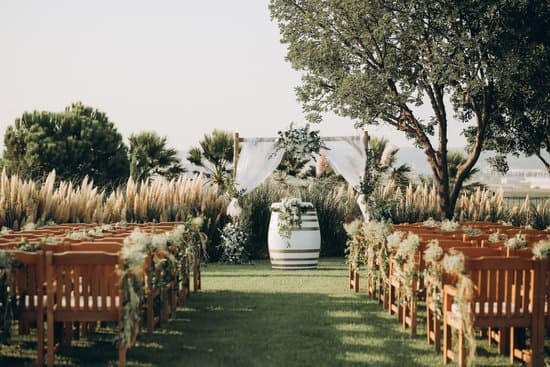Planning a wedding involves many details, and one of the most important aspects is creating the perfect wedding invitations. In this article, we will discuss how to put together wedding invitations, from choosing the design to addressing and mailing them out. Your wedding invitations are the first impression your guests will have of your special day, so it’s crucial to get them just right.
The process of putting together wedding invitations can seem overwhelming at first, but with the right guidance, it can be a fun and rewarding task. From selecting the ideal design that reflects your style as a couple to ensuring all necessary information is included, every step plays a vital role in setting the tone for your big day. So, how do you put wedding invitations together? Let’s delve into each aspect and discover everything you need to know.
In addition to discussing the importance of wedding invitations and how they set the stage for your event, we will also explore DIY versus professional printing options and provide helpful tips for assembling and mailing your invitation suite. By the end of this article, you will have all the knowledge you need to create stunning wedding invitations that leave a lasting impression on your guests.
Choosing the Perfect Wedding Invitation Design
When it comes to planning a wedding, one of the most important decisions you’ll make is choosing the perfect wedding invitation design. Your invitations will set the tone for your special day and give your guests a glimpse into what they can expect. With so many options available, it can be overwhelming to decide on the right design for your wedding invitations.
Traditional vs. Modern Designs
Before you start browsing through various designs, consider whether you want a traditional or modern invitation. Traditional designs often feature classic elements such as formal wording, script fonts, and elegant motifs like floral patterns or monograms. On the other hand, modern designs tend to be more minimalistic with contemporary typography and sleek lines.
Customization Options
Once you’ve determined whether you’re leaning towards a traditional or modern design, think about customization options that reflect your personal style and wedding theme. Many invitation designers offer customizable color schemes, paper types, and embellishments like wax seals or ribbons. Customization allows you to create an invitation that truly represents you as a couple and sets the tone for your big day.
Consider Your Wedding Theme
Lastly, when choosing a wedding invitation design, consider your overall wedding theme and color scheme. Your invitations should complement the aesthetic of your event and give guests a preview of what’s to come. Whether it’s a beachside affair with soft pastels or an elegant ballroom celebration with rich jewel tones, ensure that your chosen design aligns with the look and feel of your wedding.
Choosing the perfect wedding invitation design is an exciting part of the wedding planning process but can also feel daunting. Taking into account traditional vs. modern designs, customization options, and your overall wedding theme will help guide you in selecting an invitation that sets the stage for your special day.
Essential Information to Include in Your Wedding Invitations
When planning a wedding, it is important to carefully consider what information to include in your wedding invitations. The details you provide will ensure that your guests have all the necessary information for your special day. Here are some essential pieces of information to include in your wedding invitations:
- Date, Time, and Location: This is perhaps the most important information to include in your wedding invitations. Make sure to clearly state the date and time of the event, as well as the full address of the ceremony and reception venues.
- Dress Code: If you have a specific dress code for your wedding, such as black tie or cocktail attire, be sure to include this information on the invitation so that guests can dress accordingly.
- RSVP Details: Include a deadline for RSVPs and specify how guests should respond, whether it’s by mail, email, or through a wedding website. You may also want to include any additional RSVP cards or inserts.
In addition to these key details, you may also want to consider including other pertinent information in your wedding invitations such as accommodations for out-of-town guests, directions or a map to the venue, and any special instructions or requests for your guests.
Remember that clear and concise wording is key when including essential information in your wedding invitations. Your goal is to make it easy for your guests to understand everything they need to know about your special day with just a quick glance at the invitation. By providing all necessary details upfront, you can alleviate any potential confusion for your attendees and ensure that everything runs smoothly on the big day.
Assembling Your Invitation Suite
Once you have chosen the perfect wedding invitation design and included all the essential information, it is time to put together your invitation suite. This step-by-step guide will ensure that you assemble your wedding invitations with ease and elegance.
The first step in putting together your wedding invitations is to gather all the necessary items. This includes the invitation itself, any additional inserts such as reception cards or accommodation details, RSVP cards, envelopes, and any decorative elements such as belly bands or wax seals. Lay everything out on a clean, flat surface so you can easily access all the components.
Next, stack your invitation suite in the proper order. The traditional order for wedding invitations is to place the main invitation on the bottom, followed by any additional inserts in order of size, with the smallest item on top. Make sure that all enclosures are facing in the same direction for a polished look.
Finally, secure your invitation suite with a belly band, ribbon, or wax seal if desired. This will not only add a decorative touch but also keep all the components together as they make their way to your guests’ mailboxes. Once everything is assembled, carefully place them into the inner envelope (if using) and then into the outer envelope for a pristine presentation.
| Wedding Invitation Components | Order |
|---|---|
| Main Invitation | Bottom of stack |
| Additional Inserts | In order of size above main invitation |
| Ribbon/Belly Band/Wax Seal (optional) | Around assembled suite |
Tips for Properly Addressing and Mailing Your Invitations
When it comes to addressing and mailing your wedding invitations, attention to detail is key. After putting so much time and effort into choosing the perfect design and assembling your invitation suite, it’s important to ensure that they are properly addressed and mailed to your guests. Here are some tips for ensuring that your wedding invitations reach their recipients in a timely and professional manner.
Print or Handwrite the Addresses
One of the first decisions you’ll need to make when addressing your wedding invitations is whether to print or handwrite the addresses. While printing may be more convenient, handwritten addresses can add a personal touch to your invitations. If you choose to handwrite the addresses, make sure to use a high-quality pen with black or dark ink for legibility.
Use Proper Etiquette
When addressing your wedding invitations, it’s important to use proper etiquette for formal events. This includes using titles such as “Mr.” or “Mrs.” when addressing married couples, as well as spelling out words like “Street” and “Avenue” in full. Be sure to double-check the spelling of names and addresses, as errors can lead to delays in delivery.
Consider Hiring a Calligrapher
If you want a truly elegant and polished look for your wedding invitations, consider hiring a professional calligrapher to address the envelopes. Calligraphy adds a beautiful and sophisticated touch to your invitations, creating a memorable first impression for your guests. However, keep in mind that hiring a calligrapher can be an additional expense, so be sure to factor this into your budget.
By paying attention to these details when addressing and mailing your wedding invitations, you can ensure that they arrive at their destinations looking flawless and impressive. Whether you choose to print or handwrite the addresses, follow proper etiquette guidelines for formal events, and consider hiring a calligrapher for an extra special touch, these tips will help you put together stunning wedding invitations that set the tone for your special day.
DIY vs Professional Printing
When it comes to putting together wedding invitations, one of the big decisions you’ll have to make is whether to print them yourself or hire a professional printing service. Both options have their pros and cons, so it’s important to weigh them carefully before making a decision.
If you’re considering DIY printing, one of the biggest advantages is cost savings. With the wide availability of high-quality printers and cardstock paper, you can create beautiful invitations at a fraction of the cost of hiring a professional printer. DIY also allows for more flexibility in terms of design and timeline – you can make changes easily and print on your own schedule.
However, professional printing has its own set of advantages. One benefit is the assurance of high-quality printing and materials. Professional printers have access to a wide range of paper stocks, finishes, and customization options that may not be available with DIY printing. In addition, they often provide services such as addressing and mailing the invitations, saving you time and effort. However, it does come at a higher price point than DIY printing.
| DIY Printing | Professional Printing |
|---|---|
| Cost-effective | High-quality printing and materials |
| Flexibility in design and timeline | Access to customization options |
| No minimum order quantity | Services such as addressing and mailing |
Including RSVP Cards and Additional Inserts
When putting together your wedding invitations, it’s important to consider including RSVP cards and additional inserts to provide your guests with all the necessary details for your big day. These extra pieces help keep everything organized and make it easier for your guests to indicate their attendance. Here’s how you can include these items in your invitation suite:
- RSVP Cards: One of the most important additional inserts to include in your wedding invitations is a response card. This small card allows your guests to RSVP and indicate whether or not they will be attending your wedding. Make sure to include a self-addressed and stamped envelope with the RSVP card to make it as easy as possible for your guests to respond.
- Additional Inserts: Depending on the specific details of your wedding, you may need to include additional inserts such as accommodation information, directions, weekend itinerary, or any other relevant details for out-of-town guests. These inserts can help ensure that all of your guests have the information they need to attend and enjoy your wedding.
It’s important to keep in mind that including these additional inserts in your wedding invitation suite can add extra weight and bulk. Be sure to check with your chosen method of mailing to ensure that they meet the weight and size requirements for standard postage.
Ultimately, including RSVP cards and additional inserts in your wedding invitations is a great way to provide all the necessary information for your guests while also keeping everything organized. By carefully considering what needs to be included and how it should be presented, you can create an invitation suite that is both informative and elegant.
Ensuring a Cohesive Look
In conclusion, putting together wedding invitations is not just about selecting the perfect design and including essential information. It also involves ensuring a cohesive look by matching enclosures and envelopes. This final step in the process adds a touch of elegance and professionalism to your invitations, making them stand out to your guests.
By coordinating the color, style, and texture of your enclosures and envelopes with your invitation design, you create a unified and harmonious presentation. This attention to detail will not only impress your guests but also provide them with a seamless experience as they open their invitation suites.
Ultimately, when it comes to assembling wedding invitations, every element plays an important role in creating the overall impression. From choosing the right design to addressing and mailing the invitations properly, every step contributes to setting the tone for your special day. So remember, when putting together wedding invitations, take the time to ensure that everything from the invitation itself to its enclosures and envelopes is carefully coordinated for a polished and cohesive look.
Frequently Asked Questions
How Do You Hold Wedding Invitations Together?
There are various ways to hold wedding invitations together, including using belly bands, ribbon, twine, or wax seals. Belly bands can be customized to match the invitation design and hold all the inserts together neatly.
How Do You Structure a Wedding Invitation?
When structuring a wedding invitation, it’s important to include the hosts’ names, the couple’s names, the date and time of the ceremony, the venue(s), RSVP information, and any other pertinent details. The wording should reflect the formality and tone of the event.
How Do You Put Together an Invitation?
Putting together an invitation involves assembling all components in a specific order: the main invitation should be at the bottom, followed by any additional cards in size order. Place everything face-up with their tops aligned for a polished look. Double-check for accuracy before assembling.

I have been involved in marriages for over 20 years helping couples and singles understand more about them.





